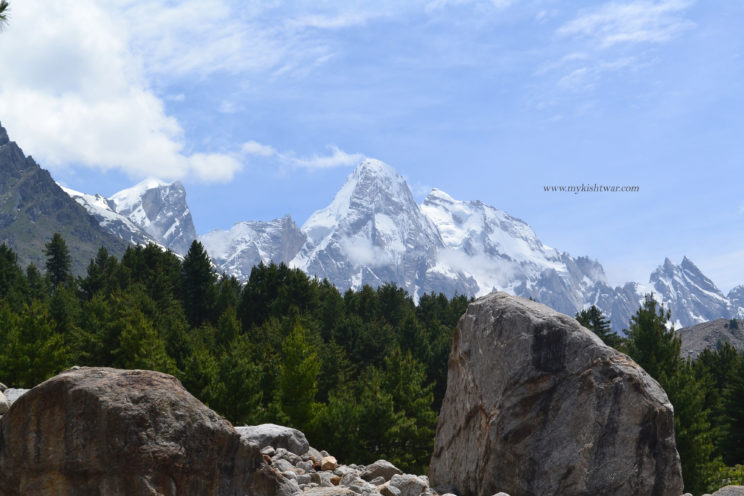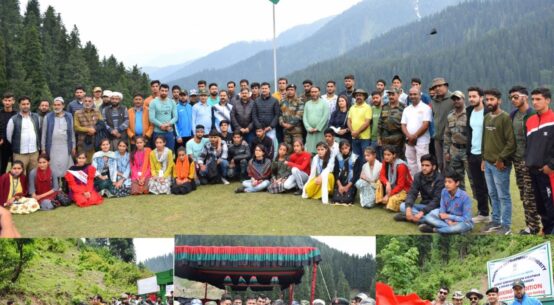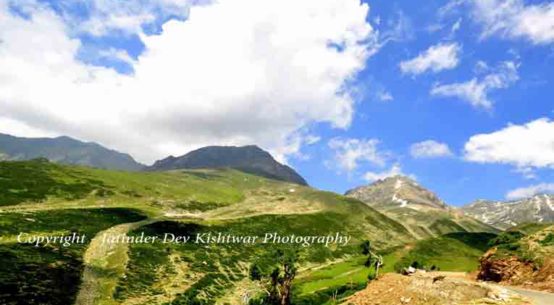
Kishtwar Himalaya is described as a small sub range of the Himalaya Mountains, in the states of Himachal Pradesh and Jammu and Kashmir. The Kishtwar Himalayan range is of sharp rocks and ice peaks. However this particular range is not so well known as compared to other sub ranges of the Himalayas. The reason behind this is that its highest peak, Bharanzar (Sickle Moon) is only 6,574 metres in altitude. Nestling on the northeast bank of the Chenab River between Kashmir to the north and Chamba Lahul to the south, Kishtwar Himalayan range is defined as mountaineer’s playground. One of the best-known peaks of Kishtwar range is Brammah I, 6,416 metres (21,050 ft).
The first mountaineers to visit Kishtwar were three Austrians who, after making the first ascent of Mulkila in Lahul in the year 1939, were interned in India at the outbreak of war. Again eight years later in 1947, at the same time while waiting for their passages back home, Fritz Kolb, with his friends Ludwig Krenek and Fabian Geduldig, visited the Kishtwar range. From a base at Machail they explored the eastern approaches to ‘Sickle Moon’, the highest peak in the range. They also climbed two small peaks. However, their first attempt to cross the main Himalayan watershed failed. They continued up the Dharlang nala and crossed the remote Poat la into Zanskar, and returned to the Kishtwar side over the Umasi la. However, the area remained almost untouched for further eighteen years when Charles Clarke led two expeditions in 1965 and 1969. During his first visit (with the Cambridge University team) he explored the central glacier system and the Kiar nala and attempted Brammah I (6416 m). The year 1969 saw him return with a few British and Indian friends to explore the Brammah glacier and Kiar nala further. They made the first ascent of Crooked Finger (5630 m) lying on the ridge north of Flat Top (6100 m).
In the year 1971, however, Charles Clarke returned once again with a British team for a serious attempt on Brammah I. Brammah I was first climbed by Nick Estcourt and Chris Bonington in the year 1973. It was again climbed by the British (A. Wheaton) in the year 1978 but two members were lost in the process. Rob Collister led a small British team to Brammah II (6425 m) in the year 1975, but failed to find a viable route. They however made an ascent of peak of 5685 metres. While the British were scouting around the Donali glacier and the Kijai nala, a Japanese team (K. Keira) made the first ascent of Brammah II from the Brammah glacier (and Nanth nala) on 15th September, 1975. The name was given much later and it is higher than Brammah I. Another Japanese expedition (F. Yuki) attempted Sickle Moon, before it finally allowed an Indian High-Altitude Warfare School expedition (Col D. N, Tanka) to make the first ascent. That was all in the year 1975.
The next year (1976) six teams visited Kishtwar Himalayan range. The rush had indeed started as the attractive challenges became more widely known. J. Cant led a British team which attempted Arjuna (6230 m) and made first ascents of ‘Sher Khan’, ‘Taragiri’ and ‘Sundar Pahar’ (all expedition names). Chris Bonington’s team attempted Katori and there were three Japanese expeditions. One made the first ascent of Pk 6550 m (Doda Peak) above ‘Durung Drung’ glacier from Abring in the Doda valley, another attempted Barnaj II (6290 m) and made the first ascent of Pk 5310 m nearby, and the third made yet another attempt on Sickle Moon. Finally a British expedition (A. Judkowski) attempted Cathedral (5370 m).
The avalanche of visits continued in the following years and between 1977 and 1985 a good number of the prominent peaks received their first ascent. Prominent amongst the first ascents, and all in the year 1977, were those of Barnaj II (central and south summits) by the Japanese (N. Kubo); ‘Viewpoint’ (5600 m) and ‘Delusion Peak’ (6560 m) by British (R. Collister); Gharol (6000 m) by the Indian Army Signals (Maj A. G. Roy). Brahmasar by the British (C, Graham); Pk 5750 m (named ‘Maguclonne’ by the team) south of Barnaj II by the British again (L. Griffin) in the year 1978; Brammah’s Wife (5297 m) by the Poles (W. Fint); Pk 6013 metres (east of Eiger), the Poles again (M. Kokaj), both in the year 1979. Flat Top (6100 m) was climbed first by the British (Maj R. Wilson) who were followed by the Italians led by A. Bergamasehi who climbed six peaks in the Durung Drung range in the year 1980.
The preserve of the British and Japanese teams was now to be shared by the Poles, Italians, French and the Dutch. D. Hillebrant led the British Padar expedition to several ascents around the Hagshu and Umasi nalas. The year 1981 was no less remarkable for its first ascents of Agyasol (6200 m) and Spire Peak (5000 m) by the British (S. Richardson). The year 1983 was a year of two spectacular first ascents – that of Kishtwar-Shivling by its north face by Stephen Venables and Dick Renshaw, and the Polish (B. Slarno) success on Arjuna (6230 m) main summit. Another first ascent that year was ‘La Shap’ (6135 m) by the French (J.P. Chassagne). The years 1984 to 1987 have been significantly active, where most of the expeditions have been exploring and attempting peaks, trying out alternate routes and in general consolidating the knowledge of the area. For instance, another fine piece of exploration-cum-ascent was that of a British team (S. Richardson) in the year 1984. The most prominent peaks of Kishtwar Himalayas are those of Tupendo I (5700 m) and II (5600 m) to its left. The latter is a snow peak (which is considered as a rarity in Kishtwar), and Richardson crossed the Agyasol glacier and climbed the broad south ridge to the summit. Richardson considers the northeast pillar of ‘Mardi Phabrang’, at the western end of the Agyasol group. Simon Richardson led another British team to a first ascent of Chomochior (6322 m) which lies between the Haptal and Chomochior glaciers.
Thus, Kishtwar Himalayan range is regarded as a prominent hunting ground as there are innumerable valleys which are yet to be explored and the sheer variety of rock and ice formation is enough to satiate the most ardent alpinist.
This article was copyright of Author originally shared by IndiaNetZone
We shared this only for information purpose and we do not claim any copyrights.

